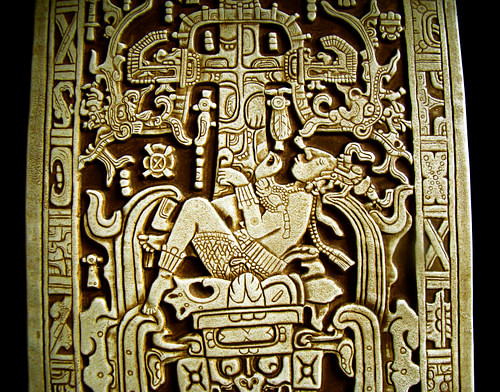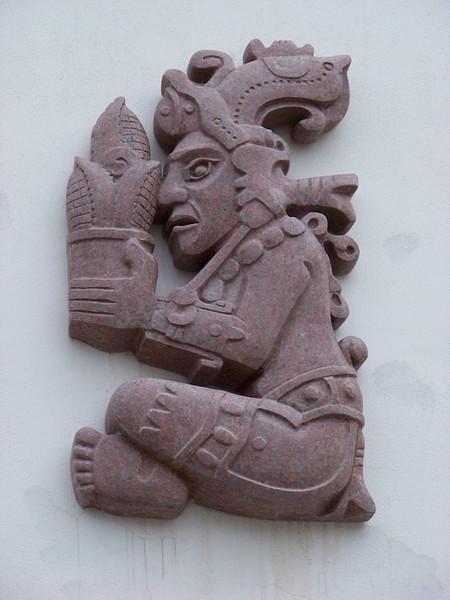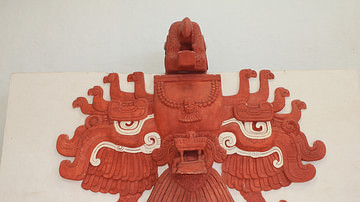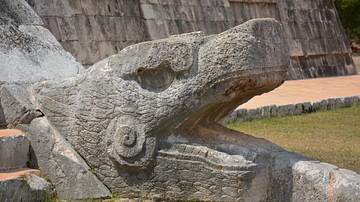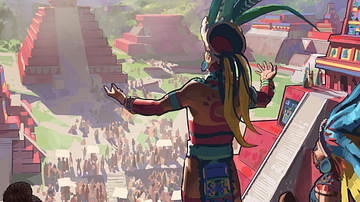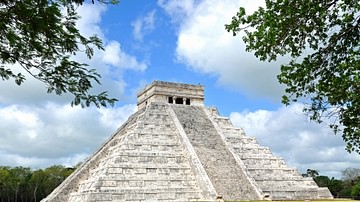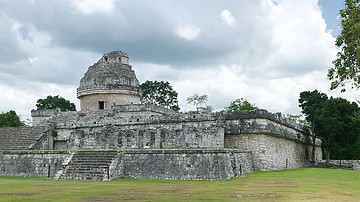The pantheon of the Maya is a vast collection of deities worshipped throughout the regions of Yucatan, Quintana Roo, Campeche, Tabasco, and Chiapas in Mexico and southward through Guatemala, Belize, El Salvador and Honduras. These gods informed the lives and rituals of the people, established order, and provided hope of a life after death.
Not all of the gods were venerated in all of the city-states of the Maya (at least, not by the same name) but the type of god, and what that god symbolized to the people, seems to have been universally recognized. An example of this can be seen in the different names given to the underworld by the Yucatec Maya of the north and the Quiche Maya of the south. The Quiche called their underworld `Xibalba' while the Yucatec referred to the same place as `Metnal'. Though the names were different, the characteristics of the dark `land of fright', through which a soul had to travel after death, were the same.
Another instance of this can be seen in the creation myths where, for the Quiche, thirteen gods were involved in creating human beings from maize while, to the Yucatec, it was only two. Still, the message of the myths is the same: the gods struggled to create human beings just as humans struggle with their own attempts at creation and survival and, also, that life comes from the earth (here, in the form of corn, the staple of the Mayan diet) and so the earth must be honored and respected.
The gods were involved in every aspect of the life of the Maya. They controlled the weather, the harvest, they dictated one's mate, presided over every birth, and were present at one's death. As the gods were depicted as cross-eyed, mothers would dangle a bead from the forehead of their children so that their eyes would become crossed. Similarly, children's heads were bound, especially males, in order to elongate the forehead in emulation of the gods, especially the very popular Maize God figure. The clothing worn by the nobility, and especially the ruler of a city, mimicked the dress of the gods. The way in which a city was planned and the precision with which the central temples were constructed all followed from an understanding of the way of the gods.
The great Temple of Kukulcan at Chichen Itza is an embodiment of the secular calendar (the Haab) of 365 days but is also very specifically designed to make the god known as the Plumed Serpent back to earth twice a year. At the two equinoxes, each year, people still gather for this event. The steps of the Temple of Kukulcan (also known as El Castillo) run steeply down from the temple at the summit of the pyramid to stone serpent heads at the base of the stairs. On the twin equinoxes each year, the sun casts the shadow of a serpent which moves slowly down the stairs from the temple to the stone heads and creates the image of a serpent descending to the earth. Kukulcan (also known as Gucamatz and, more famously, Quetzalcoatl) was the most popular god among the Maya and it is not surprising that, even today, many of the Maya, and non-Mayan people, congregate at the temple twice a year to receive the blessings of his visit to the earth.
There were over 250 deities in the pantheon of the Maya and, owing to the mass burning of their books by Bishop Diego de Landa in 1562, much information about the gods (and Maya culture) was irretrievably lost. The Quiche Mayan religious text, the Popol Vuh, gives one set of names for the gods which the Yucatec Maya knew by other names.
Some gods remain unidentified while others' provenance is unclear or has become conflated with still other deities or with Christian concepts. Scholars are hardly in agreement over the age and prestige of the `king' of the gods, Hunab Ku, for example, whom some claim an ancient lineage for while others maintain a post-conquest status. Some scholars adamantly defend their definition of a certain god while other scholars maintain an opposing one and there is strong evidence for the truth of both sides. The following list, then, is by no means comprehensive as far as defining every god the ancient Maya worshipped in every region, village, or city but attempts to be comprehensive in detailing as much as is presently known about the gods and hopes to do so concisely.
`A'
A Maya god of death whose name is not yet known. He is depicted ruling a part of the underworld surrounded by the bones of his subjects. His symbols are a skull and obsidian knife, both related to the practice of human sacrifice.
Acan
The god of intoxication, wine, and the art of brewing Balche (a kind of strong mead). His name means either `belch' or `groan' and he is associated with the Lacandon Maya god of drunkenness Bohr (also known as Bol).
Acat
The god of the art of tattooing and patron of tattoo artists, Acat is also associated with the growth and development of fetuses. He is further designated by the names Acat-Cib and Ah - Kat.
Ah-Bolom-Tzacab
The leaf-nosed god of agriculture (also known as Ah-Bolon-Dz'acab).
Ah-Cancum
A god of hunting.
Ah-Chun-Caan
A tutelary deity, he provided protection at sunrise and sunset.
Ah-Chuy-Kat
A minor god of war whose name means Fire Destroyer.
Ah-Ciliz
The god of solar eclipses.
Ah-Cun-Can
A war god known as the Serpent Charmer.
Ah-Cuxtal
The god of birth. His name means `Come to Life' and he was responsible for the safe delivery of babies into the earthly realm, both physically and spiritually. After a birth he would wash his hands and then move on to the next one.
Ahau-Chamahez
One of two great gods of medicine and healing (with Cit-Bolon-Tun) known as the Lord of the Magic Tooth.
Ahluic
The god of merchants and material wealth often depicted as a member of a triad, with the deities Chac and Hobnil.
Ahmucen-Cab
A creator god who, according to the Chilam Balam creation story, covered the faces of the thirteen gods of the day and let them be captured by the nine gods of the night. During this captivity, he spread seeds and set boulders across the land which grew out of the darkness. This act of creation was later un-done and re-worked by the Becabs.
Ah-Hulneb
A minor god of water.
Ah-Kin
A deity who is an aspect of the sun god (Kinich Ahau) and controls drought and disease (also known as Ah-Kinchil).
Ah-Kumix-Unicob
These were minor water gods who attended to Cenotes and pools.
Ah-Mun
A god of fertility and protection who was also a personification of Maize.
Ah-Muzencab
The deities who presided over and cared for bees. They are also associated with air elemental spirits.
Ah-Patnar-Unicob
These deities were elemental gods of water. They were the lords of the Eight Day Rain Ceremony during which they were celebrated.
Ah-Pekku
A god of thunder.
Ah-Puch
A god of death, darkness, and disaster but also of regeneration, child birth, and beginnings. According to the Quiche Maya, he ruled over the underworld of Xibalba while according to the Yucatec Maya he was one of many of the Lords of Metnal (same as Xibalba). He is associated with Cizen, Yom Cimil/Yum Cimil (though Cizen seems to consistently be imagined more darkly).
Ah-Tabai
The god of the hunt and protector of animals.
Ah-Uaynih
The goddess of sleep. She was especially helpful in putting men to sleep.
Ah-Uncir-Dz'acab
The god of natural healing.
Ah-Uuc-Ticab
A Chthonic deity.
Ah-Wink-Ir-Masa
A nature goddess who protected wild animals, she is associated with deer.
Ah-Xoc-Xin
The god of poetry and music, he was an aspect of the sun god Kinich Ahau.
Ahau-Chamahez
A god of medicine and healing.
Ahau-Kin
An aspect of the sun god also known as Jaguar Lord and Lord of the Underworld.
Ahmakiq
A god of agriculture and cultivated crops.
Ahulane
A war god associated with archery and known as The Archer.
Ajbit
One of the thirteen gods who assisted in the creation of human beings from Maize following two previous failed attempts.
Ajtzak
One of the thirteen gods involved in the attempts to create human beings.
Akhushtal
The goddess of childbirth.
Akna
A title applied to Akhushtal, among other goddesses, which means `Our Mother', and was closely associated with those deities concerned with fertility and childbirth.
Alaghom-Naom-Tzentel
The goddess of thought and intellect. She was also known as Ixtat-Ix.
Alom
One of the thirteen gods who participated in the creation of human beings. After the successful third attempt, he became known as Hunahpu-Guch.
Bacabs
The four gods of the winds and the directions who hold up the four corners of the world. In Yucatec Maya they are known as Muluc (of the east) Kan (of the south) Ix (of the north) and Cauac (of the west). Muluc and Kan generated positive energies while Ix and Cauac brought negative forces. This confluence of negative and positive energy enabled the early gods to create human beings and the physical and non-physical worlds. They are associated with the deities Acat, Akna, Backlum Chamm, and Chin.
Backlum Chaam
One of the Bacabs or an aspect of the Bacabs, he is the god of male sexuality.
B'alam
The Jaguar deities who protect individual communities against external threat. They also guard and protect people in daily life.
The B'alams
In the Quiche Maya tradition the Balams were the four gods who made possible the creation of man after two previous failed attempts. They were known as B'alam Agab (Night Jaguar) B'alam Quitze (Smiling Jaguar) Iqi B'alam (Dark Jaguar) and Mahucatah (Not Right Now). According to one myth, their fellow gods grew jealous of their abilities and so clouded their sight, rendering them mortal.
Bitol
One of the thirteen gods who participated in the creation of human beings. After the successful third attempt, he became known as Ixmacane (he is the early version of Ixmacane, a later god).
Bolon-D'zacab
The lightning god and patron of the harvest.
Bolontiku
A group of nine chthonic beings of the underworld, they were associated with regeneration.
Buluc-Chabtan
Also known as `God F', this deity is the god of war, violence and death to whom human beings were sacrificed regularly. In the Dresden Codices he is depicted as being eaten by maggots. He is further depicted setting homes on fire, killing people, and roasting them on skewers over a fire.
Cabaguil
One of the thirteen gods who assisted in the creation of human beings. His name means `Heart of the Sky'.
Cabrakan
Also known as Caprakan, he was the god of earthquakes and mountains. He was the son of the gods Vucub Caquix and Chimalmat and plays a significant role early in the Popol Vuh where he is defeated by the Hero Twins as is his brother Zipacna.
Cacoch
A creator god who presides over creativity and communication (especially relating to divine communications).
Cakulha
A lesser god of lightning bolts who, with his brother Coyopa, assist the supreme god of lightning, Yaluk, in creating the storms sent by the rain god Chac.
Camalotz
The servant of Alom who, after the second attempt at creation, beheaded most of the people in the world in order that the gods could begin again. His name means `Sudden Blood-letter'.
Camazotz
The bat god of Xibalba who feeds on blood. In the Popol Vuh he tears off the head of one of the Hero Twins, Hun Hunahpu, who is then revived by his brother. Camazotz was then defeated and cast out of creation.
Camaxtli
The Maya god of fate who was known to the Aztecs as Mixcoatl or Mixcoatl-Camaxtli. He was associated with war, hunting, and creation and was credited with bringing fire to earth.
Caprakan
See Cabrakan
Cauac
One of the four Bacabs, Cauac controls the westerly direction and the west wind. Also known as Zac-Cimi.
Chac
The supreme god of storms and rain and associated with agriculture and fertility. He was known as the Lord of the Rains and Winds and maintained important water sources such as cenotes, wells, streams, and springs. He was widely popular and prayers and sacrifices were frequently offered to court his favor and that of the four, lesser, chacs. A lord of the sky, he was the sworn enemy of Camazotz of Xibalba and was thought of as a caring, if unpredictable, deity.
Chacs
These were four weather spirits, located at each of the corners of the world, who were under the command of the great god Chac and did his bidding.
Chac-Uayab-Xoc
The protector of fish and patron of fisherman.
Chamer
One of the gods of death and regeneration of Xibalba.
Chen
Also known as Chin, she was the goddess of maize, magic, and a councilor to the kings. She was also closely associated with homo-erotic relationships and homosexuality. According to the priest Las Cassas, she introduced homosexuality to the Maya nobles who encouraged their children to enter into homosexual marriages. She is associated with the moon and, sometimes, is depicted as a male deity.
Chicchan
These were four rain gods, from the four corners of the world, who were associated with the Bacabs.
Chin
Widely known as the Maya goddess of homosexuality. See Chen.
Chirakan-Ixmucane
A creator goddess who was formed out of four earlier creators and listed among the thirteen divinities who first engaged in the creation of human beings.
Cit-Bolon-Tum
One of two great healer gods (with Ahau-Chamahez).
Cizin
Also known as, or associated with, the names Kisen, Yom Cimil, Yum Cimil, and Ah Puch, he was a god of death who lived in Xibalba (Metnal to the Yucatec Maya) and is often pictured as a dancing human skeleton smoking a cigarette. He is further identified by his `death collar' of human eyes dangling from nerve endings. Cizin came upon one suddenly and without warning but was accompanied by a foul smell and so was called `The Stinking One'. Unlike the other death god aspects with whom he is associated, Cizin is not associated with regeneration or re-birth. He keeps the souls of evil people in the underworld where they are subjected to his torments and trickery. Post-conquest, he became closely identified with the Christian devil.
Colel Cab
An earth goddess who cares especially for the bees. She is still invoked by modern-day Maya Daykeepers in chants to ward off attacks on nests, remedy nest problems, and aid hive keepers with their bees.
Colop-U-Uichikin
God of the sky and particularly of eclipses.
Cotzbalam
A servant of Alom who followed after Camalotz after the failed second attempt at creation and devoured the bodies of the people who were beheaded. His name means`Crunching Jaguar'.
Coyopa
A lesser god of sound and of thunder who works with his brother Cakulha under the guidance of the supreme god lightning, Yaluk, to create the storms sent by the rain god Chac.
Cuchumaquic
A lord of Xibalba whose name means `Blood Gatherer'. He is the father of the goddess Xquic and grandfather of the Hero Twins, Hunahpu and Xbalanque.
Cum Hau
A god of death and regeneration who lived in Xibalba.
`E'
An agricultural god whose name is not yet known.
Ekchuah
A god also known as Ek Ahau and, earlier, as only `God M'. He presides over and protects travelers, merchants, and warriors and is depicted as a dark-skinned male carrying a bag over his shoulder. He is also recognized as the patron and protector of cacao and cacao products.
El Gran Dios
`The Great God' who was the god of the Christians and dwelled in the seventh level above the earth. In some stories he is associated with Hunab Ku. This figure is a late, post-conquest, addition to the Maya pantheon
`F'
A god of war associated with human sacrifice and repeated victories over Ekchuah. He is also known as Buluc-Chabtan. See Buluc-Chabtan.
Four Hundred Boys
Considered to be patron deities of alcohol and, later, the Pleiades. In the Popol Vuh, the Four Hundred Boys were youths who wished to build a hut on the beach but could not lift the massive tree they had cut down to use as the main support column. They asked the giant Zipacna, who was reclining nearby, for help. Zipacna agreed to use his great strength to move the tree but mocked the boys for their weakness and their inability to do so themselves. The boys agreed together that Zipacna should be killed but he overheard their plan, tricked them into thinking he was dead, and killed them. They ascended into the heavens and may be seen today as the star cluster known as the Pleiades. Zipacna was later killed by the Hero Twins.
Gucumatz
This god is one of the most important, if not the most important, in the pantheon of the Maya. The name Gucumatz (also Gukumatz) is the Quiche Maya designation for the god known to the Yucatec Maya as Kukulcan and most famously, in the Nahuatl language, as Quetzalcoatl (`the plumed serpent' or `the quetzal-featherd serpent') who was worshipped as early as the first century BCE at the great city of Teotihuacan. Gucumatz is identified as one of thirteen deities who shaped the world and created human beings. From Gucumatz, humans learned the rules of law, agriculture, literacy, the arts, medicine, architecture, construction, hunting, fishing, and all other aspects of civilization. He is said to have come from the sea, conveyed to the people his gifts and ruled wisely over them, and then returned to the sea, promising to come back one day. The god of all four elements, he was also the representation of the co-mingling of good and evil, light and darkness, and so became a central figure in many of the myths of the Maya and popularly depicted, in various forms, in virtually every city-state. As Kukulcan, he is the great plumed serpent who glides down the steps of El Castillo at Chichen Itza on the spring and autumn equinoxes and is thought to bring positive energy to the earth and to those present at his descent.
Gucup Cakix
This deity, also known as Vucub-Caquix (which means `Seven Macaw') is depicted in the Popol Vuh as an arrogant bird demon who pretended to be both the sun and the moon and thus threw life out of balance until he was defeated by Hunahpu and Xbalanque, the Hero Twins. He was the father of Cabrakan and Zipacna who were also overthrown by the famous twins.
Hacha'kyum
An astral god who created the stars by scattering sand into the sky. He was the patron deity of the Lacandon Maya.
Hapikern
An adversarial deity, Hapikern is the world-girdling serpent who is perpetually at war with his brother, Nohochacyum, the great god of creation and protection, and is fated to be destroyed by that god in a final battle. His other brothers are Usukun, Uyitzin, and Yantho, all three of whom are haters of humanity, and also the brother of Xamaniqinqu, the god of merchants and travelers.
Hero Twins
Hunahpu and Xbalanque (also given as Ixbalanque) are the two great mythical heroes of the Maya whose story is preserved in the Quiche Maya work `The Popol Vuh'. They were born of the virgin goddess Xquic after the severed head of their father, Hun Hunahpu, spit into her hand from a calabash tree in the underworld of Xibalba. Raised by their mother and grandmother the twins became great ball players, excelling at `the game of the gods', Poc-a-Toc. Once attaining manhood, they avenged themselves on the Lords of Xibalba, who had murdered their father and uncle, by accepting their invitation to the underworld where a series of traps and tests awaited them. They escaped the traps and snares set for them and defeated the forces of chaos and darkness. They then attempted to bring Hun Hunahpu back to life and, though they succeeded in putting his body back together and reanimating him, he could not return to the earth above. The twins promised him, however, that humans would pray to him for hope and comfort and he would be remembered and honored. The promise was kept as Hun Hunahpu became the Maize god, a dying-and-reviving god figure, who appears on earth as corn. Ascending from Xibalba, they meant to stop in the middle world of the earth but continued climbing up the World Tree and into paradise where, even then, they desired to climb higher and so became the sun and the moon (in another version the gods reward them for their victory by turning them into the sun and the moon). The Hero Twins have been thought to represent the legitimacy of the Maya ruling class, though this theory has been disputed. There is no doubt that their story was very popular among the Maya as the twins are depicted in art work throughout the region, often playing their famous game. Based upon these paintings, it seems clear there were many tales concerning the hero twins which have been lost and the Popol Vuh is the only surviving text of their story.
Hobnil
A god of agriculture and prosperity and a member of a triad with the deities Ahluic and Chac.
Hozanek
A god of the south, associated with the Bacab Cauac and the color yellow. He is a son of the
great couple Itzamna and Ixchel.
Hun-Batz
One of the two stepbrothers of the Hero Twins (the other being Hun-Chowen) also known as `One Howler Monkey' and depicted as a howler monkey. Along with his brother, he is the patron god of artists and writers.
Hun-Came
Also known as Hun-Cane, he is a lord of the underworld who, along with Gucup Cakix, kill Hun Hunahpu, the father of the Hero Twins. He is later killed by them.
Hun-Chowen
One of the two stepbrothers of the Hero Twins (the other being Hun-Batz) he is depicted as a howler monkey. Along with his brother, he is the patron god of artists and writers.
Hunab-Ku
While Gucumatz was the most popular god, Hunab-Ku is considered the supreme deity of the pantheon of the Maya, known as `Sole God'. While some scholars have asserted his antiquity, he seems most likely a concept which arose following the Christianization of the Maya during the Spanish Conquest and closely resembles the Christian god. He is invisible and without form but can be apprehended through his aspect in the god Itzamna, referred to as his son. Hunab-Ku is the husband of Ixazalvoh, the divine mother, associated with water, life, and weaving. Some inscriptions refer to him as `The Eyes and Ears of the Sun' in substantiating the claim that, like the Christian god, he is ubiquitous and knows all.
Hun-Hunahpu
Also known as The Maize God, Huh Hunahpu died but was regenerated by his sons, and returns to life as maize (corn) and so is identified as a dying-and-reviving god figure. The father of the great Hero Twins Hunahpu and Xbalanque. Hun-Hunahpu and his twin brother, Vucub Hunahpu, were demi-gods who, after the creation of the world, became proficient in the `ball game of the gods', Poc-a-Toc. The lords of Xibalba, beneath the earth, became enraged by the noise of the twins and so devised a plan to get rid of them. They invited the young men to the underworld to play a game of Poc-a Toc. Before the game could begin, however, the twins were tricked by the Xibalbans and killed. Hun-Hunahpu's head was placed in the axis of a calabash tree which grew heavy with strange fruit. The young virgin Xquiq came upon the tree and, reaching for the fruit, was asked by the head to open her palm. Hun Hunahpu's head spat into the maiden's hand and she became pregnant with Hunahpu and Xbalanque. The head then sent the girl to live with his mother, Xumucane.
Hunahpu
One of the great Hero Twins who feature prominently in the myths of the Maya and in the text of the Quiche work, the Popol Vuh. Son of Hun Hunahpu amd Xquiq, Hunahpu is the god of the evening who restores the stars to the sky and, with his brother, Xbalanque, defeated the lords of Xibalba and created order on the earth. He is associated with the sun and, in some myths, is the sun himself.
Hunahpu-Gutch
The name which the god Alom took after the successful third attempt at creating human beings.
Hunahpu-Utiu
A deity among the original thirteen who assisted in the creation of human beings.
Hun-Nal-Ye
A god of salt water and the sea who was the patron of sharks.
Huracan
Also known as `Heart of the Sky' and `One-Leg', Huracan is a storm god. In the Popol Vuh he is the supreme creator of earth who thinks existence into being, participates in the creation of human beings, and sends the great flood to destroy his inferior creations. He is further referred to as Lord of the Whirlwind and credited as one of the gods (sometimes the sole god) to give fire to humans.
`I'
An early goddess of water presiding over the sea, springs, and wells whose name is unknown but is thought possibly to be `Ixik'.
Itzamna
Considered the founder of the Maya culture, patron and protector of priests and scribes, Itzamna is an extremely important and popular god. Like Gucumatz, he taught the people the arts of literacy, medicine, science, art, sculpture, and agriculture. He created and ordered the calendar and instructed humans in the proper cultivation of maize and cacao. He is a creator and healer who can resurrect the dead. In later, post-Colombian writings, he is referred to as the son of Hunab-Ku and takes on many of the characteristics associated with the Christ figure. He is associated with the prophet Zamna, who brought the sacred writings to the city of Izamal on the command of the great goddess and also with Kinich Ahau, the sun god. In one myth he is the father of the Bacabs.
Itzam-Ye
Also known as Itzam-Yeh, The Serpent Bird, The Celestial Bird, and The Way of Itzamna, Itzam-Ye was a deity in bird form which nested in the axis of the great Ceiba tree, the World Tree, which connected the underworld with the middle world (earth) and upper world. From its perch, Itzam-Ye could see all of creation and knew all the secrets of all three planes of existence. Images of the bird god in the sacred tree have been found throughout many Maya sites and, usually, engraved on temples and shrines where the Daykeepers would chant and cast the spells which protected the world from chaos and maintained order. Itzam-Ye was considered a master of the spiritual world and well versed in what, today, would be considered sorcery and magical arts.
Ixazaluoh
A goddess associated with water and weaving.
Ixazalvoh
The Divine mother and consort of Hunab-Ku, Ixazalvoh is the goddess of water, life, and weaving. She also presides over female sexuality and childbirth and is known for her powers in healing. Her oracles were considered important conduits for divine messages for the people.
Ixbalanque
One of the great Hero Twins whose adventures are told in the Popol Vuh. See Xbalanque.
Ixchel
Known popularly today as `the rainbow goddess' because her name could be translated as `Lady Rainbow', Ixchel is associated with many different aspects of life and cosmology. Although images of her in modern times almost universally depict her as an attractive young woman with long, dark hair seated on, or near, a rainbow, ancient Maya images consistently portray her as an old, plump woman with sharp features and jaguar ears, often wearing a headpiece with a live serpent springing forth and carrying a water jug. Ixchel has been associated with the so-called `goddess O' of the Dresden Codex, obviously a rain deity, and so is thought to be a goddess of the rain, perhaps a consort of Chac. She is, however, also associated with war as she is sometimes depicted in ancient images with claws and surrounded by or adorned with bones. Diego de Landa reported that she was the "goddess of making children" and also of medicine. Evidence suggests that Daykeepers and physicians consulted with Ixchel in their arts but, at the same time, she is associated through other evidence with the moon and mutability and, further, with weaving and the arts. According to a Verapaz myth, she was the consort of Itzamna and bore him thirteen sons. Whatever her main provenance was, it is certain that she was greatly venerated by women and, especially, those who were pregnant or wished to become so. Her shrine on the island of Cozumel was extremely popular and became one of the most important pilgrimage sites for the ancient Maya. The island which Cortez named the Isla Mujeres (Island of women) was so designated because of the number of goddess statues found there, Ixchel among them. Shrines to Ixchel may still be seen throughout the Yucatan today, especially on Cozumel, where her image has become conflated with that of the Virgin Mary and the two now share the veneration and prayers of the women who continue to make the pilgrimage to the island.
Ixcuiname
The goddess of the four ages of womankind (though whether this means four time periods in which women have existed or the four stages in a woman's life of child, maiden, mother, crone is unclear). Her name is interpreted as `Four Sisters' or `Four Faces'. She has been associated with the four creator gods Alom, Bitol, Qaholom, and Tzacol and, through this relationship, became known as Chirakan-Ixmucane, one of the thirteen deities who created human beings.
Ixmacane
One of the thirteen gods who participated in the creation of human beings, his name is the final form of the deity originally called Bitol (although the same name has been applied to other gods in their `final form' following creation).
Ixmucane
One of the thirteen gods who participated in the creation of human beings according to one version of the myth. Also a version of the name Xumucane, the grandmother of the famous hero twins, who, with her husband, Xpiayoc, created humans from maize and are considered the oldest and wisest deities in the Maya pantheon.
Ixpiyacoc
The name of the creator god Tzacol who, after the successful third attempt at creating human beings split into two separate entities and became both Tzacol and Ixpiyacoc. Also a variant spelling of Xpiayoc, the husband of Xumucane, who helped in creating humans from maize.
Ixtab
Also known as `Rope Woman', Ixtab was the goddess of suicides and, particularly, those who died by hanging. She is depicted as the rotting corpse of a woman hanging from a noose in the heavens which appears in the Dresden Codex. As suicide was considered an honorable alternative to living among the Maya, self-inflicted death guaranteed one an instant passage to paradise, by-passing the dark and dangerous underworld of Xibalba. Ixtab would escort the souls of suicides to paradise where they would enjoy eternal pleasure surrounded by other blessed souls such as those who died in battle, in childbirth, as sacrificial victims, or on the ball court playing Poc-a-Toc.
Ix-Tub-Tun
A serpent deity who spits precious stones and is associated with rain.
`K'
The name by which the god K'awi (or K'awiil) was formerly known. K'awai is the patron god of royalty, kingship, and the nobility.
Kan
One of the principal Becabs, Kan known as the Upholder of the South.
Kan-U-Uayeyab
A patron god of cities, guardian of urban communities.
Kan-Xib-Yui
One of the creator gods who is sometimes mentioned as one of the original thirteen who created human beings. Probably originally a local fertility deity who was included as a creator-god, he does not appear on all lists of the thirteen.
Kianto
Also known as Kiant, he is the god of unwelcome influences which were designated primarily as disease and foreigners.
Kichigonai
In the Quiche Maya tradition, Kichigonai is the creator of day and the god of light.
Kinich Ahau
The sun god known as `Face of the Sun' and sometimes referred to as Kinich Ajaw. He was a god of healing and medicine. The later god, Hunab Ku is thought to be a conflation of Kinich Ahau and the Christian God. In some early myths, Kinich Ahau is the consort of the goddess Ixazalvoh whereas post-conquest stories place the divine mother with Hunab Ku.
Kinich Kakmo
The patron god of the city of Izamal, a solar deity who was represented by a macaw.
Kisin
Another name for Cisin, the most commonly depicted god of death, but also the name of an earthquake god associated with the ongoing enmity between Nohochacyum and Hapikern and the Yantho Triad.
Kukulcan
See Gucamatz
`L'
A god of the evening, of darkness and night whose name is not yet known.
Maize God
A dying-and-reviving god figure in the form of Hun Hunahpu who was killed by the Lords of Xibalba, brought back to life by his sons, the Hero Twins, and emerges from the underworld as corn. The “Tonsured” Maize god or “Foliated” Maize god are common images found throughout the region. He is always pictured as eternally young and handsome with an elongated head like a corncob, long, flowing hair like corn silk, and ornamented with jade to symbolize the corn stalk.
Mam
A title of respect meaning `Grandfather' and applied to a number of different Maya deities including earth spirits, mountain spirits, and the four Bacabs. The god known as Mam Maximon is a post-conquest god of travelers, merchants, witchcraft, and bad luck that was conflated with the Christian figure of Judas and in modern times is part of the celebrations surrounding Holy Week.
Manik
The god of sacrifice, of sacrificial victims, and of purifying suffering.
Mitnal
Also known as `Metnal' , this is the Yucatec Maya word for the Underworld and corresponds with the Quiche Maya vision known as Xibalba. According to the Popl Vuh, Mitnal was a dark land flowing with rivers of blood and pus and populated by deities with names such as Bloody Teeth, Bloody Claws, and Flying Scab, among others.
Mulac
One of the four Bacabs and known as `Upholder of the East'.
Naum
The god who created the human mind and consciousness.
Nacon
The god of war.
Nohochacyum
A creator-destroyer deity, the brother of the death god Kisin (or possibly another earthquake god also known as Kisin). He is the sworn enemy of the world serpent Hapikern and it is said that, in the end of days, he will destroy Hapikern by wrapping him around himself to smother him. In some versions of this story, life on earth is destroyed in the process. He is related, in some stories, to Usukan, Uyitzin, Yantho and Hapikern, all of whom wish human beings ill. Also the brother of Xamaniqinqu, the patron god of travelers and merchants.
Och-Kan
Also known as Ochan and Ahacan, he is the great Vision Serpent of the Maya. A Daykeeper (shaman) would have to experience the Vision Serpent first hand in order to understand the realm in which he was dealing and finalize his initiation into the mysteries. Och-Kan's presence was announced by a herald god named Uc-Zip in the underworld of Xibalba.
Paddler Gods
Two deities who paddle the divine canoe through the underworld and up into the sky. They row on opposite sides of the vessel with Old Jaguar Paddler in the front and Old Stingray Paddler in the back. They participated in the building of the Cosmic Hearth for the gods at the beginning of creation and are thought to symbolize night and day, light and darkness, and the eternal dance of opposites. They are also seen as representations of the Milky Way.
Pawahtuun
A calendar deity associated with the four Bacabs and the end of the year. He positions himself at the four corners of the sky and thus holds up the world.
Poxlom
The god of diseases.
Qaholom
One of the gods who participated in the creation of human beings along with Alom, Bitol, and Tzacol.
Q'uq'umatz
See Gucamatz
Tecumbalam
The great bird sent to break the bones and rend the muscles of the human beings who displeased the gods and were destroyed in the great flood sent by Hurakan.
Tepeu
One of the creator gods who participated, sometimes with Gucumatz and Huracan, in creating human beings.
Tlacolotl
The god of evil, of those who practice evil, and of the dark places where evil plans are made. The Maya also attributed earthquakes to him.
Tohil
The god of fire who was the patron deity of the Quiche Maya city of Q'umarka.
Tzacol
One of the thirteen gods who participated in the creation of human beings. After the successful third attempt, he split into two separate deities, Tzacol and Ixpiyacoc.
Tzultacaj
Also known as Tzuultaq'ah, he was the god of mountains and valleys.
Uc-Zip
A herald god to the Lords of Xibalba who announced the coming of the great Vision Serpent Och-Kan.
Usukan
A fearsome god who hates human beings and has the earthquake as his servant in his attempt to destroy human life. His brother is Hapikern, the world-girdling serpent, who is also hostile to humanity. He is almost always listed along with Uyitzin and Yantho in what is known as the `Yantho Triad' of supernatural `villains'. Xamaniqinqu, the god of travelers and merchants, is another brother.
Uyitzin
One of the fraternal triad with Usukan and Yantho, three brothers who hate humanity and are the enemies of the god Nohochacyum, who is also sometimes depicted as their brother as is Xamaniqinqu.
Vision Serpent
A mystical snake-god who was of great importance to the Maya as he knew the secrets of the universe and could impart these secrets to a Daykeeper (shaman). See Och-Kan.
Voltan
A chthonic deity who was lord of drums. He is not to be confused with Votan which is a god often invoked in the modern day `New Age' movement but has no basis in fact in the ancient Maya pantheon. Voltan seems to have been a mortal who was deified for his great deeds and was married to the goddess Ixchel.
Vukub-Cakix
A giant bird god with emerald teeth who did battle with, and was ultimately defeated by, Hun Hunahpu and Vukub Hunahpu, the father and uncle of the Hero Twins. Also known as Vucub-Caquix.
Vukubcane
A Lord of the underworld Metnal (Xibalba) in the Quiche Maya work The Popol Vuh.
Ways
In the Maya belief, every day has its own energy and this energy will either aid or hinder one in one's path on a given day. The Ways (Wayobs) are any one of a class of protector spirits whose energy aids and directs one through the course of a day and, so, in life. Every person has a Way who tends to that individual spiritually. A Way may manifest itself physically as an animal to help guide someone and, in this aspect, they would be recognized as Totems or Totemic Guides. The Ways may also communicate through dreams in which a dreamer is brought to the Wayib (the Dreaming Place) where the individual soul may commune directly with their Way. Even the gods of the Maya have a Way attached to them which guides and directs the energy of the deity if that god is open to such guidance.
World Tree
The great Ceiba Tree of Life (also known as Yaxche) which has its roots in the underworld, grows up through the middle world (earth) and has its branches in paradise. The World tree grows up through the nine levels of Xibalba, passes through the earth, and continues on up through the thirteen levels to Tamoanchan (paradise). The base of the world tree grows from the cracked shell of the Cosmic Turtle and the limbs can be seen as the Milky Way in a north-south orientation. In the axis of the World Tree sits the bird-god Itzam-Ye who knows all the secrets of the three planes of existence.
Witzob
The Maya believed the gods lived on mountains and Witzob means `mountain' and signifies the holy mountain of the gods in Tamoanchan. The mountain was not considered simply as a mass of inert rock, however, but as a living thing imbued with the same spiritual energy that coursed through a human being and through all living things. Mountains, owing to their height, became manifestations of spiritual power and influence. The famous temples of the Maya, all throughout the region from Chichen Itza down to Altun Ha, are artificial mountains built specifically to make the patron god of that particular city, and his or her friends and attendants, feel at home.
Xamaniqinqu
The patron god of merchants and travelers, god of the north and the northern energies, and brother to Nohochacyum, Yantho, Usukun, and Uyitzin. He is also known as Xaman Ek.
Xbalanque
One of the great Hero Twins who feature prominently in the myths of the Maya and in the text of the Quiche Maya work, the Popol Vuh. The son of Hun Hunahpu and Xquiq, Xbalanque is considered the warrior twin who leads the way through the underworld and, with his brother Hunahpu, defeats the lords of Xibalba to create order on the earth. He is associated with the moon and, in some stories, is the moon.
Xecotcovach
A bird servant of the god Alom. His name means `Face Gouger' and he participated in the destruction of the inferior human beings of the second creation attempt by tearing out their eyes.
Xibalba
The Quiche Maya term for the underworld which corresponds to the Yucatec Maya word `Metnal'. The name means `Place of Fright' and was thought to be populated by the Xibalbans who were dark, secretive, dangerous and hostile to human beings. At death, the soul of the individual had to pass through Xibalba before reaching paradise and, if that soul were particularly unfit, would remain in Xibalba at the mercy of various deities like Cizen for an eternity. At the same time, however, it should be noted that a number of the Lords of Xibalba are associated with regeneration and re-birth and in no way should Xibalba be equated with the Christian concept of hell.
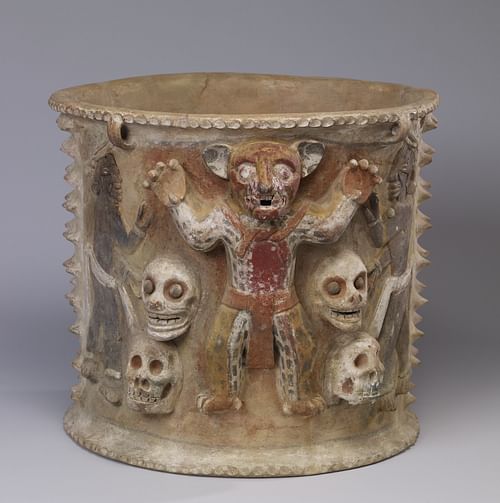
Xumucane and Xpiayoc
The parents of Hun Hunahpu and Vucub Hunahpu, grandparents of the Hero Twins, most ancient of the gods of the Maya pantheon, and the divine couple and first Daykeepers who helped to create human beings. According to the Quiche Maya, after the thirteen creator gods failed in their attempt to make human beings, they consulted with the much older gods, Xumucane and Xpiayoc to find out what they were doing wrong. They asked the ancient couple if wood could be a proper medium for the fashioning of humans. The two Daykeepers consulted the sacred calendar and said that wood seemed a workable material but, when the wooden humans were made, they were unacceptable. They could walk and talk but had no respect for the gods and could not consult the calendar; so the gods destroyed them in a great flood. Xumucane then ground white and yellow corn (maize) and washed her hands, saving the water to brew a sacred broth which gave life to the humans who were created from the maize, thus beginning human life on the earth. Xumucane is the great grandmother and Xpiayoc the great grandfather of all human beings. She is known as the divine mid-wife responsible for all births and he is the divine matchmaker in charge of arranging all marriages. As the first two Daykeepers they are closely associated with the sacred calendar.
Xquiq
Also known as Xquic, Blood Moon Goddess, and Blood Maiden, she is the daughter of Cuchumaquic, one of the Lords of Xibalba, and the virgin mother of the Hero Twins, Hunahpu and Xbalanque. After the Lords of Xibalba murdered Hun Hunahpu and Vucub Hunahpu, they placed Hun Hunahpu's severed head in the axis of a calabash tree in the underworld as a warning sign to others that they were not to be trifled with. Xquiq was drawn by the strange fruit of the tree and, on approaching, was addressed by the head of Hun Hunahpu who then spit in her open palm. She became pregnant with the hero twins and, following Hun Hunahpu's command, left Xibalba and presented herself to his mother, Xumucane. After she passed a test to authenticate her identity, she gave birth to the twins who then were mainly raised by their grandmother. She is identified with the waning moon as Xumucane is with the waxing moon, is also identified with Venus, and depicted as a goddess of fertility and motherhood.
Yaluk
The supreme lightning god who creates the storms sent by the rain god Chac. He is assisted by the two fraternal deities, Coyopa and Cakulha.
Yantho
A deity hostile to humanity and linked to his brothers, Usukun and Uyitzin, in a triad, usually mentioned together, who despise human beings and take joy in human distress. They are associated with earthquakes and destruction and are brothers to the benevolent Nohochacyum, the god of merchants and travelers, Xamaniqinqu, and the world-girdling serpent, Hapikern.
Yaxche
The World Tree also known as The Tree of Life. See World Tree.
Yumbalamob
Protecting spirits who inhabit the first level just above the earth and are the guardians and protectors of Christians. In the daylight they are invisible but, at night, they position themselves by the crosses which the faithful have erected outside of their homes and stand guard. Wielding obsidian knives, they cut through the winds which would harm a Christian village and, also with these knives, fend off the dangers of the surrounding jungle and send messages to each other.
Yum Caax
The god of the woods, of nature, of cacao, plants, and of the hunt. Also known as Yom Caax, Yum Kaax, Yum Ka'ax, he was regularly invoked by farmers before clearing the land for cultivation. He is regarded as a benevolent god who protects the plants and animals for human use and sustenance. He is able to either guide a hunter's arrow to a great kill or turn the arrow back on the hunter if proper obeisance and respect has not been given.
Yum Cimil
One of the Lords of Xibalba and closely associated with Ah Puch and Cizin. Like Cizin, he wears a collar of dangling eyes and is depicted as skeletal with bones adorning his meager clothing.
Yumchakob
Also known as Nukuchyumchakob, these are white-haired, elderly deities in charge of dispensing rain. The Yumchakob are kindly disposed toward human beings and love to smoke cigars. They are associated with Kukulkan and, according to some scholars, the great god was once one of their number before descending to earth. In post-conquest Yucatan they were depicted as dwelling in the sixth level above the earth just below El Gran Dios, the Christian god.
Zac-Cimi
One of the four Bacabs. See Cauac.
Zipacna
An arrogant giant whose story is told in the Popol Vuh. He was the son of Vucub Caquix and Chimalmat and the brother of Cabrakan and, like the rest of his family, was known for his arrogance. He is famous for two events: the tale of the Four Hundred Boys and his death at the hands of the Hero Twins, Hunahpu and Xbalanque, which they accomplished by dropping a mountain on him. See Four Hundred Boys.
Zotz
The god of bats, caves, and patron of the Tzotzil tribe. Also known as Zotzilaha and Sotz.
